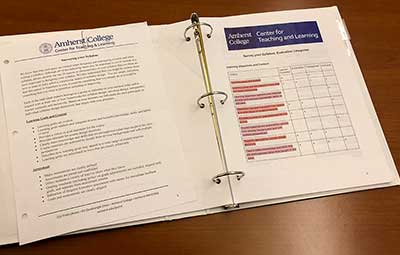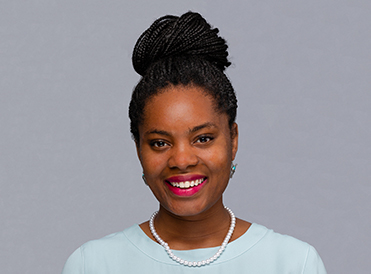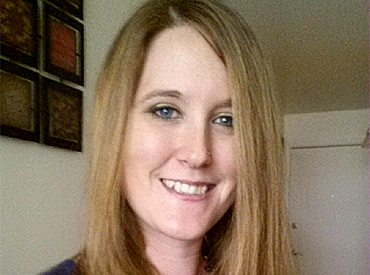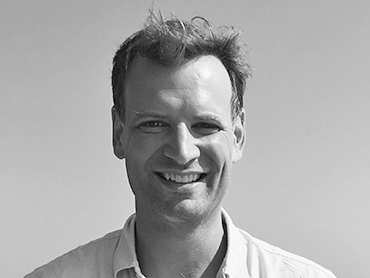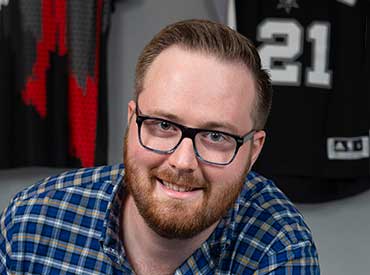Like students in a new class, faculty in the workshop had to make themselves vulnerable, be confused and learn many new concepts, while “fighting the war with perfectionism and trying to get out of my own way,” to quote Allison Formanack, Center for Humanistic Inquiry Fellow and visiting lecturer in anthropology. She was working on a syllabus for her course “American Housing: Foundations and Futures.”
Caldwell-O’Keefe was encouraging: “This is a low-stress situation this week. We want to meet you wherever you are.” Indeed, piles of colorful markers and pipe cleaners sat on the tables. “We like to have something there for no purpose,” explained Jyl Gentzler, who teaches philosophy and is the faculty director of the CTL. Formanack promptly started fashioning cat toys from the pile of wire and chenille.
Some of the syllabus components seemed straightforward: explaining how to order course books, for instance, or listing office hours—though Laura Wenk, associate professor of cognition and education at Hampshire, made sure to define the term “office hours” in her syllabus. She explained why to the group: “I had a student who told me ‘I thought office hours were when we shouldn’t bother you.’”
We want to shift away from looking at a syllabus as a contract, to looking at it as a tool to establish and sustain a relationship with students.” —Riley Caldwell-O’Keefe
Some professors remembered one component (like resource links) but forgot another (like accommodations policies) and were glad to be reminded by their peers. One asked if they should detail how students could decide if they were ready for the course. Latinx historian Stephanie Huezo, of Mount Holyoke, said she was an advocate of pre-testing her students to gauge their level of knowledge and so teach accordingly. That was just one of many freely crowdsourced ideas.
Lots of folks doubled down on refining their course’s “learning goal” in their syllabus. Old-school syllabi usually leave this out, or conflate it with course content (i.e., you’ll learn about apartheid or quantum physics). Visiting Assistant Professor of Statistics Ryan McShane, who was developing a syllabus for “Introduction to Statistics via Modeling,” was able to distinguish the two: “Learning how to do a t-test is a topic. But ‘You’ll be able to read a newspaper article and understand the statistic’ is the learning goal.”
Assistant Professor of Classics Andreas T. Zanker (who goes by Tom) was laboring over his syllabus for “Roman Civilization.” He’d embedded a “secret question” in a previous syllabus which, if a student emails him the answer, counts for 1 percent of their grade. It’s a sneaky way to see if a student has read through the document, and it sets a fun tone. To that end, the others convinced Zanker to cut a daunting syllabus image of Zeus throwing a thunderbolt. “You don’t want them to think that represents your grading policy,” joked Sarah Bunnell, associate director and STEM specialist at the CTL. This got a big laugh. He replaced it with a more welcoming picture.
Many of the faculty struggled with nuances of tone, and Caldwell-O’Keefe rolled out examples of syllabi with “cold” and “warm” word choices. Younger faculty, especially younger faculty of color, wanted to be seen as inviting, but not so much that they would lose students’ respect.
Studies show that students, especially first-generation students, are more likely to skip enrolling in a class where the professor sounds adversarial in the syllabus, rather than supportive. In one sample, for instance, the professor required that an absence due to a death in the student’s family had to be confirmed with a death certificate. “I felt like that was written by someone who is burned out, or does not like students,” said Amy Nussbaum, visiting lecturer in statistics at Mount Holyoke.
A lot of the participants appreciated that several syllabi used the kinder section heading “Class Citizenship” or “Academic Integrity” rather than “Plagiarism Policy” and also spelled out what constituted plagiarism. Wenk listed not only what she expected from her students, but what they could expect from her. “I love your transparency here!” said Jallicia Jolly, a Consortium for Faculty Diversity Pre-Doctoral Fellow and visiting instructor of American studies and Black studies who was working on her syllabus for “Black Women and Reproductive Justice in the African Diaspora.”
A different sample syllabus, for a history course, gave detailed instructions on workload per week, broken down by increasing categories of strenuousness, described as “wading, snorkeling, and scuba diving.” Caldwell-O’Keefe encouraged the workshoppers to consult this course workload estimator, developed at Rice University, to fine-tune their class assignments and help their students keep up throughout the semester.
Sony Coráñez Bolton, assistant professor of Spanish, appreciated the snorkeling metaphor, how it showed that the professor was framing the workload in clear and friendly ways. As Bolton told the group, “I want my students to know this is a thoughtful document, with no finger-wagging.” Bolton worked on the syllabus for “Comparative Borderlands: Race, Gender and Sexuality in Transnational Perspective.”
Added Caldwell-O’Keefe, “What comes up for me over and over in this conversation is that designing a syllabus requires you to think really carefully about who you are as a teacher, and what you value. This points to how critical a document a syllabus can be—because it conveys all these pieces.”
